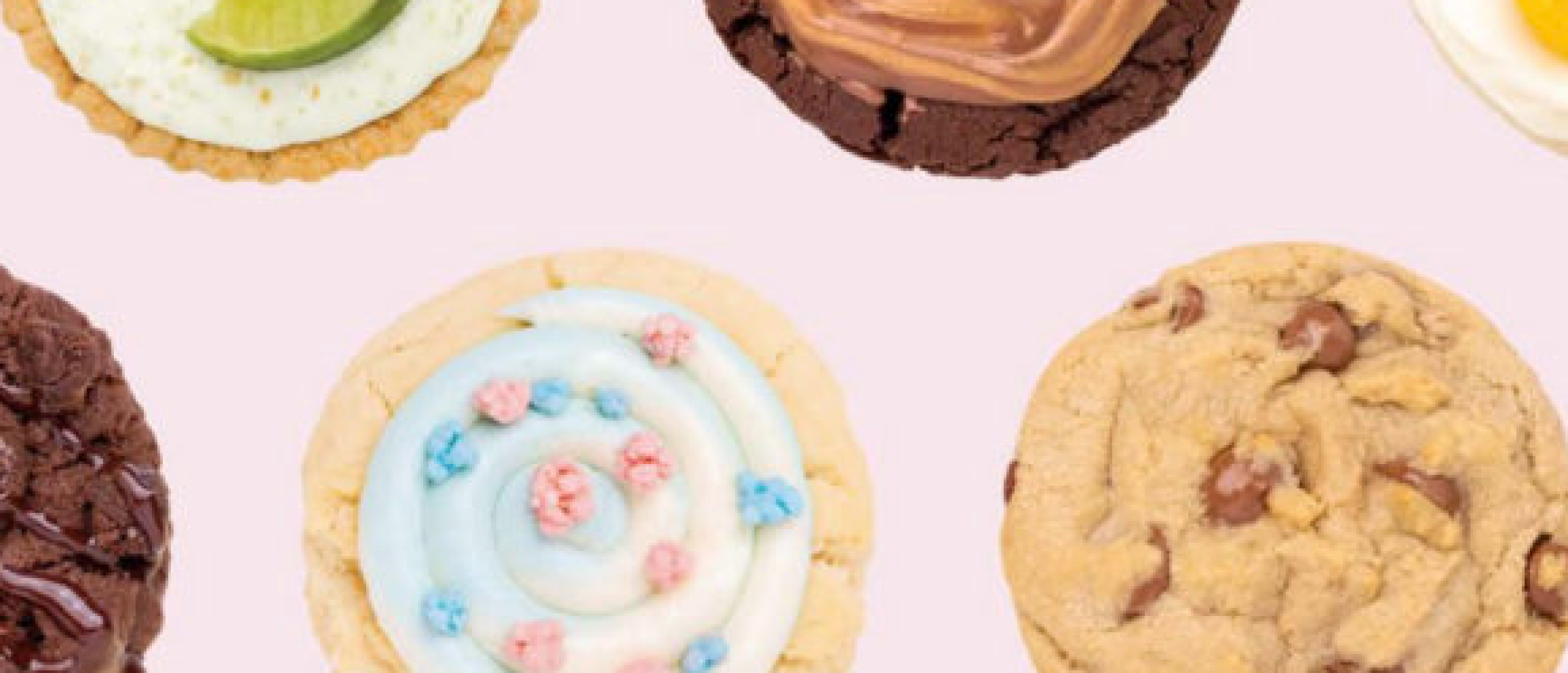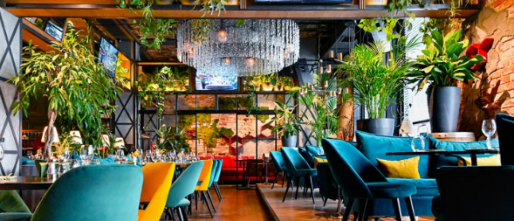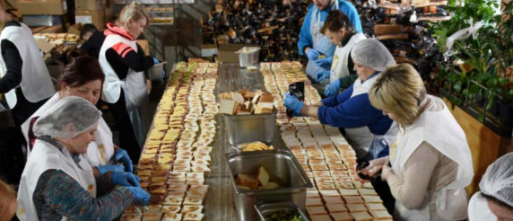Cousins Jason McGowan and Sawyer Hemsley tell Elly Earls how they have grown Crumbl Cookies from one store in Utah to an empire of more than 300 across the US in less than five years
It started as one store in Logan, Utah, less than five years ago. Now, Crumbl is the fastest growing cookie chain in the US, with 300 stores across 35 states. According to its founders, cousins Jason McGowan and Sawyer Hemsley, the brand’s rapid expansion has been possible because of their focus on customer feedback, investment in ‘people-first’ technology and an ever-changing menu that creates exclusivity and provides a constant stream of content on social media.
Baking has been part of Hemsley’s life since he was a child. “I grew up making cookies with my mom and grandma,” says the Crumbl chief operating officer. “I loved being in the kitchen and being creative.” When he was a student at Utah State, he decided he wanted to make a treat that was perfect for college students. He took to the kitchen again and teamed up with his cousin McGowan to take his cookie experiments to gas stations and grocery stores on the weekends. It was the first iteration of a practice that’s become central to the Crumbl brand – testing and gathering customer feedback.
The pair expanded their efforts and eventually landed on the chocolate chip cookie recipe for which Crumbl has since become famous. They opened their first store in Logan, Utah in 2017 while Hemsley was still at university and the pair spent every spare moment they had working on the business.
From the outset, they wanted the baking process to be as transparent as possible. Customers can see their cookies being mixed, balled, baked and dressed in real time. But while Hemsley and McGowan started off offering only milk chocolate chip cookies for take-out and delivery, their operation has expanded somewhat in size – and complexity – in the intervening years.
Crumbl now offers curbside pick-up, catering and nationwide shipping and has a rotating menu that draws from over 200 flavors inspired by different kinds of desserts. Recent examples include banana cream pie, ruby chocolate chip, raspberry lemonade and caramel popcorn. Some of the most popular flavors are the cornbread cookie, the Twix cookie, anything with Oreo and the original rec–––ipe. But no matter how popular a particular cookie becomes, it will always be replaced after seven days with one of the next five flavors.
Social media success
The ever-changing menu may pose operational challenges such as sourcing, quality assurance and training, but the exclusivity it creates has brought Crumbl incredible reach on social media, something that’s been an integral part of the brand’s business model since day one.
Every Sunday, Crumbl releases its new menu on Instagram, TikTok and Twitter, driving hundreds of thousands of likes and sometimes more than a million views. The brand has seen particular success on short-form video sharing platform TikTok, where, in February, it had 3.6 million followers, significantly more than Nike, at 2.1 million. This number may well have increased since.
“Our entire approach is catered perfectly to TikTok,” says CEO McGowan. “We release top-notch content that is compelling and shareable. Third-party creators then supplement this content by offering their opinions and validation to our weekly rotating flavors.”
Indeed, TikTok creators line up every week to try each of the five weekly rotating cookies and let their audiences know how they rank the flavors from one to 10 in their #crumbl review videos. Some have even created TikTok accounts focused solely on Crumbl, which the brand does not pay for. “It’s an incredible thing to witness,” McGowan says. “We love that our cookies have become part of so many people’s weekly routines.”
Crumbl also has 1.7 million Instagram followers; on this platform, the brand’s distinctive pink boxes take center stage. The team tries to respond to every story mention and review. Meanwhile, on Reddit, Crumbl aficionados spend hours putting together flavor lists and guessing which cookies will be coming next week.
People-first technology
The way Crumbl operates – with its rotating menu and focus on takeaway, delivery and curbside pick-up – means technology, both front and back of house, has been a key priority for McGowan and Hemsley.
While the brand’s customer-facing app allows people to order, choose a delivery method and send cookies to their friends and family via its gifting feature, Crumbl also has an internal app through which management can communicate with franchise partners.
“The very core of Crumbl’s success is our people-first technology,” stresses Hemsley. “Because of our weekly-rotating menu and 300+ locations across the nation, reliable technology that allows us to communicate with franchise partners and update recipes on a dime is crucial to our business model. All of our technology is designed with people – be it franchise partners, customers, and businesses – in mind to create a positive experience all around.”
The company’s customer-facing app was ranked number 10 in food and drink daily downloads in the iOS store in February according to App Annie, outpacing the likes of the US’s largest fast-food chain, Subway as well as Pizza Hut, Chipotle and Burger King.
Hemsley and McGowan chose a franchise model for Crumbl because they wanted their business to be something that could also help other succeed. So far, they’ve had no issues finding franchise partners, most of whom were customers before they decided to join the business. “We want partners who are passionate about Crumbl,” McGowan explains. “They love the product so much, they want to be a part of it.”
The cousins put a huge effort into ensuring franchise partners feel supported, as Hemsley explains: “The training and onboarding process is robust, setting partners up for success from the very beginning. Franchise partners are trained on every aspect of the business and are given personalized support from corporate, even long after they have opened their store. Additionally, ongoing support and communication is facilitated through the internal app.”
He adds that the national recognition and tight-knit Crumbl community are additional factors that attract franchise partners to the brand. “It’s instantly recognizable at this point, and that is something that franchise partners are interested in being a part of,” he notes. “Plus, the internal Crumbl community is strong. Our franchise partners gain support not only from corporate, but also from other franchise partners and fans.”
Crumbl has also launched partnerships with established foodservice brands to further grow their reach and recognition. In October 2021, they teamed up with Mondelez International to launch a Golden OREO cookie, which, like every Crumbl cookie, was available for one week only.
“[Partnerships like these] increase our credibility with customers and creates a positive outlook for our consumers,” says Hemsley. “We have more collaborations to come this year and cannot wait to work with some incredibly talented companies.”
Listening to customers
Crumbl had only been in business for three years when the pandemic ripped through the foodservice industry. Even though the operation was already set up to provide carry-out and delivery, it was a trying time.
“We leaned into our technology a lot during the pandemic. And we focused on the expansion of our curbside pick-up and self-serve kiosks,” McGowan says. “Sourcing right now is still a challenge in the food industry and that’s why a popular cookie may take a while longer to come back, but we have pivoted and made changes just like everyone else.”
Crumbl doesn’t plan to limit its business to national borders. Global expansion, says Hemsley, is in “the near future.” In the meantime, he and McGowan will stick with what’s working. “We would say that customers will want more convenience from brands in the months and years to come,” he concludes. “It won’t be enough to have the best-looking product or the fastest service. Consumers will want brands and companies to listen to the feedback they have and appreciate the fact they listen.”







